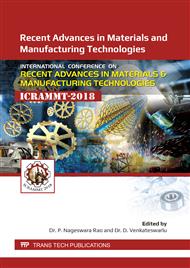[1]
BP Energy Outlook: BP energy economics (2018) 1-125. (bp.com/energy outlook).
Google Scholar
[2]
V. Vibhanshu, A. Karnwal, A. Deep, N. Kumar, Performance, Emission and Combustion, Analysis of Diesel Engine Fueled with Blends of Mahua Oil Methyl Ester and Diesel, SAE International Technical Paper 2014-01-2651, (2014). (.
DOI: 10.4271/2014-01-2651
Google Scholar
[3]
BP Energy Outlook: Country and regional insights - India (2018) 1-2. (bp.com/energy outlook).
Google Scholar
[4]
M. Das, M. Sarkar, A. Datta, A.K. Santra, An experimental study on the combustion, performance and emission characteristics of a diesel engine fuelled with diesel-castor oil biodiesel blends, Renewable Energy, (2017). (.
DOI: 10.1016/j.renene.2017.12.014
Google Scholar
[5]
M.A. Asokan, S.S. Prabu, S. Kamesh, W. Khan, Performance, combustion and emission characteristics of diesel engine fuelled with papaya and watermelon seed oil bio-diesel/diesel blends, Energy, (2018). (.
DOI: 10.1016/j.energy.2017.12.140
Google Scholar
[6]
B.R. Hosamani, V.V. Katti, Experimental analysis of combustion characteristics of CI DI VCR engine using mixture of two biodiesel blend with diesel, Engineering Science and Technology, an International Journal, (2018) 1-9. (https://doi.org/10.1016/j.jestch.2018.05.015).
DOI: 10.1016/j.jestch.2018.05.015
Google Scholar
[7]
B. Mazumdar, A.K. Agarwal, Performance, emission and combustion characteristics of biodiesel (waste cooking oil methyl ester) fueled IDI diesel engine, SAE International 2008-01-1384, (2008) 1-13.
DOI: 10.4271/2008-01-1384
Google Scholar
[8]
S. Sinha, A.K. Agarwal, Experimental investigation of the combustion characteristics of a biodiesel (rice-bran oil methyl ester)-fuelled direct-injection transportation diesel engine, Proceedings of the Institution of Mechanical Engineers, Part D: Journal of Automobile Engineering, 220 (2007) 921-932. (.
DOI: 10.1243/09544070jauto220
Google Scholar
[9]
S.C. Sekhar, K. Karuppasamy, N. Vedaraman, A.E. Kabeel, R. Sathyamurthy, M. Elkelawy, H.A.E. Bastawissi, Biodiesel production process optimization from Pithecellobium dulce seed oil: Performance, combustion, and emission analysis on compression ignition engine fuelled with diesel/biodiesel blends, Energy Conversion and Management, 161 (2018) 141-154. (https://doi.org/10.1016/j.enconman.2018.01.074).
DOI: 10.1016/j.enconman.2018.01.074
Google Scholar
[10]
A. Uyumaz, Combustion, performance and emission characteristics of a DI diesel engine fueled with mustard oil biodiesel fuel blends at different engine loads, Fuel, 212 (2018) 256-267. (http://dx.doi.org/10.1016/j.fuel.2017.09.005).
DOI: 10.1016/j.fuel.2017.09.005
Google Scholar
[11]
E. Rajasekar, S. Selvi, Review of combustion characteristics of CI engines fueled with biodiesel, Renewable and Sustainable Energy Reviews, 35 (2014) 390-399. (http://dx.doi.org/10.1016/j.rser.2014.04.006).
DOI: 10.1016/j.rser.2014.04.006
Google Scholar
[12]
A. Sharma, S. Murugan, Investigation on the behaviour of a DI diesel engine fueled with Jatropha Methyl Ester (JME) and Tyre Pyrolysis Oil (TPO) blends, Fuel 108 (2013) 699-708. (http://dx.doi.org/10.1016/j.fuel.2012.12.042).
DOI: 10.1016/j.fuel.2012.12.042
Google Scholar
[13]
J.B. Heywood, Internal combustion engine fundamentals, McGraw-Hill (1988) ISBN: 0-07-028637-X.
Google Scholar
[14]
M. Singh, M.Y. Sheikh, D. Singh, P.N. Rao, Combustion characteristics of CI diesel engine fuelled with blends of Jatropha oil biodiesel, IOP Conf. Series: Material Science and Engineering 330 012075 (2018) 1-7. (.
DOI: 10.1088/1757-899x/330/1/012075
Google Scholar
[15]
B.G. Rao, Y.D. Bharadwaz, C. Virajitha, V.D. Rao, Effect of injection parameters on the performance and emission characteristics of a variable compression ratio diesel engine with plastic oil blends - an experimental study, Energy & Environment, (2018) 1-19. (.
DOI: 10.1177/0958305x17753208
Google Scholar
[16]
S. Szwaja, Simplified calculation of combustion progress in the IC engine, TEKA Kom. Mot. Energ. Roln.-OL PAN 11 (2011) 386-396.
Google Scholar
[17]
M. Singh, F.A. Khan, V. Yadav, M.Y. Sheikh, Y.B. Mathur, Experimentally combustion analysis of diesel engine using medium concentration of Jatropha biodiesel, IJIRSET 6 (2017) 20780-20792. (.
Google Scholar



